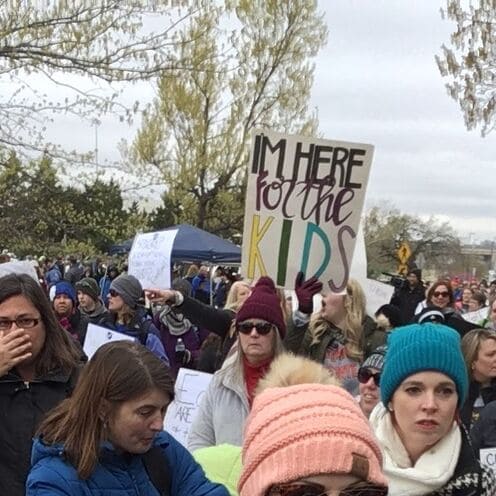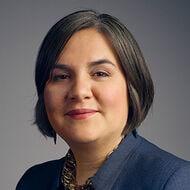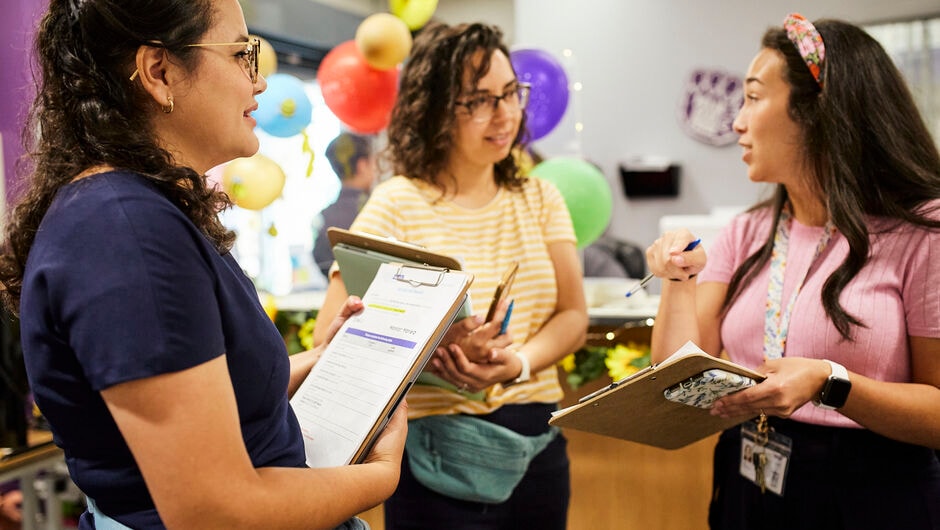
Standing for Students, Schools, and Teachers
An inside account of how leaders from across the education system came together to advocate for change on behalf of Oklahoma’s students and teachers.
The past few years have seen renewed activism by teachers and their supporters. Many public schools don’t have the resources they need to provide the quality of education students need and deserve. And many teachers work multiple jobs to make ends meet and yet still pay out of pocket to ensure their classrooms have the supplies their students need to thrive and learn.
In response, teachers have occasionally made their voices heard by walking out of their classrooms, demanding better for their students and themselves.
Oklahoma was one place where teachers and other educational leaders, with support from many others in the broader community, decided to take action and stage a walkout in April 2018. This is the story of how they exercised their collective leadership during that period, as told by members of the Teach For America network who were there.
The Oklahoma walkout began on April 2 of that year, and school was closed for the duration of the walkout. During that time, teachers and their supporters lobbied and rallied at the state capitol and elsewhere, including a group who marched the 110 miles from Tulsa to the state capitol building in Oklahoma City. At the same time, teachers, school-system leaders, and community members organized to ensure that students were safe and cared for during this time.
When the walkout ended on April 12, the teachers had achieved an average $6,000 raise--$1,250 for support staff--and millions of additional spending, funded by the first tax hike in nearly three decades. But they still fell short of their original goals. At the time, union leaders called for the effort to move to the ballot box, which many educators took to heart, inspired by the walkout to run for office themselves.
As a new school year dawns, that spirit of activism continues nationwide: A recent poll found a majority of American teachers would vote to go on strike to advocate for elevated education funding and teacher pay--a stance supported by nearly three-quarters of the general public, according to the same poll. At Teach For America, we believe teacher pay and adequate resources for schools are critical to achieving excellence and equity in education for students and families. With debate and activism over these issues continuing, we asked several members of the Teach For America Oklahoma network who were there--teachers and system leaders--to share their memories and reflections of that time, when leaders at every level came together to advocate for change.
Laying the Groundwork
Amy Shelton (Oklahoma ‘11) was an elected Tulsa Public Schools board member during the walkout. I, along with my fellow board members and Tulsa Public Schools administrators, signed a commitment card stating we "support our teachers in job actions such as working the contract, participating in organized walk-outs, and engaging in a state-wide shutdown of our public education system." We as a board authorized our superintendent to close schools during the walk-out.
Oklahoma City officials likewise decided to close. Rebecca Kaye (Atlanta ‘00), who currently serves as the chief of equity and accountability for Oklahoma City Public Schools, was the district’s acting superintendent at the time. She explains: The reality for us is that if a large number of our teachers don't come to school, then we really can't have school. It was really mission-critical for us to get a substantial increase in education funding and teacher salaries because, quite frankly, we had been losing 25 percent of our teachers every year from Oklahoma City Public Schools [many of whom left for better-paying teaching jobs in neighboring Texas]. It's not possible for us to make strategic improvement if we're basically constantly teaching new people how to be teachers.
The Walkout Begins
When the walkout began on April 2, schools closed and teachers and their supporters gathered at the state capitol and elsewhere to raise their voices and lobby legislators.
Like Amy, Rebecca supported the striking teachers: This was so teacher led. It was really inspiring to watch it unfold because it was really the power of social media to bring people together and to help people bounce ideas off of each other.
A group of seven Tulsa teachers offered their collective and individual memories and reflections. The group is comprised of Anne-Therese "AT" Ryan, Meredith Cooper, and Kristi Stiles from Tulsa Honor Academy, and Christian Barrera, Neal Patel, Faith Brown, and Luke Rose from Nathan Hale Junior High School (all Tulsa ‘17). They describe the first day of the walkout: We collectively saw our role as one to lift up the voices of our students. Many of us woke up before dawn to carpool to the Capitol, as Tulsa is about a two-hour drive from Oklahoma City. We made our way to the Capitol, and Day One of the walkout had begun. When we got to the Capitol, there was a sea of over 40,000 people. There were teachers from all across Oklahoma and neighboring states chanting for a fair wage.
Like everyone who contributed to this story, Rebecca, the acting superintendent, was deeply concerned at every step of the way about the students and families who would be impacted by the walkout and resulting school closures. The first thing that I thought of was, I don't know what's going to happen to our 46,000 kids if they are thrust into a situation where our community has not planned for this time. Parents haven't planned for childcare. Parents haven't budgeted for feeding their kids at home. In a Community Eligibility district, every single one of our kids gets free breakfast, lunch, and snacks every day.
One thing that I will say about Oklahoma, we have this thing called the Oklahoma Standard that is really a legacy of the Oklahoma City bombing. It is a phrase we use to describe the way our community takes care of each other when there's a crisis. Our community stepped up. Our foundations came to the table. We had meetings of dozens and dozens of community partners. The city of Oklahoma City opened their recreation centers to our kids during the day when they usually don't open them until after school. Feed the Children delivered tens of thousands of take-home meals to kids.
Our operations team came up with this plan to use our school buses as food trucks, mobile feeding sites. There was a network of buses that went out and sat at schools and parks and recreation centers and neighborhood locations and delivered lunches to kids.
The Tulsa teachers say their biggest takeaway from Day 1 of the walkout was the clear support they felt from the community. From students and families who were unable to go that wrote letters to their representatives, to grocery stores that donated food, to family members and friends from around the country who donated money, to all the eating establishments in Tulsa that were giving teachers discounts during this time. We were a part of something much bigger than what we expected as teachers.
Amy, the former board member, recalls how she spent her time during the walkout: I attended rallies and a town hall, cheered for teachers as they worked the contract, stood with teachers holding signs on a street corner during the walk-out, traveled to the Capitol to join the fight for funding, and marched along with teachers and supporters.
Lifting Voices, Taking Action
On the morning of the third day of the walkout, the group of Tulsa teachers woke before dawn to travel to Oklahoma City with a group of students. They describe how the day unfolded: We had loaded up our backpacks with sack lunches, water, and first aid kits. Our students were ecstatic to be at the Capitol, and for many of them it was their first time in Oklahoma City. Throughout the day there were some uncomfortable situations, from the heat to long lines to very confined and crowded spaces. However, our students had such an optimistic and happy outlook on the day, many of them eager for the chance to speak with a representative. Toward the end of the day, we were able to get into the Capitol and a few of the students were given the opportunity to speak to local legislators.
Faith Brown, one of the group from Tulsa, remembers: The atmosphere was buzzing with excitement, with the possibility for change. For the first time, I saw that leadership isn’t lonely; it’s community. As I looked around at my students that day, I realized education cannot be contained in a classroom.
Jessi Hicks (Tulsa ‘16), a teacher at Hamilton Elementary School in Tulsa, participated in the 110-mile walk from Tulsa to Oklahoma City with fellow teachers: We walked between 10 and 20 miles every day. In every town we walked through we were greeted with so much kindness and support--honks and waves from passing cars, whole families standing out with signs cheering us on, people stationed giving out water and snacks, donated lunches. We did have a handful of negative responses from people driving by. But the ratio of positive to negative responses was 100:1, if not higher. We passed a daycare one day, and all the kids came out with shiny star balloons and gave one to each of us. I remember thinking, "This is who we're doing all this for, the kids."
The days weren't always so pleasant, though. Weather was not on our side. One of the teachers came up with a chant towards the end of the walk: “Rain, snow, earthquakes, lightening, nothing can stop us from doing the right thing!” We literally had all of those happen while we were walking.
Rebecca describes experiencing the last legs of the Tulsa-to-Oklahoma march: Their last stop before they walked to the Capitol was at our offices here at Northeast Academy, which is about three quarters of a mile from the Capitol. We got one of our high school marching bands to come out, and we were able to accompany them for the last leg of the march.
Avery Smith (Oklahoma City ‘17), a high school math teacher, decided to fast from food for the duration of the walkout--11 days. He explains why: The fast was a way for me to stay grounded in the fact that the walkout was a sacrifice for our families. It reminded me this wasn't just a celebration of education at the Capitol--it was a fight we needed to win as quickly as possible. It was also a way to communicate how serious we were about the walkout. A lot of legislators didn't think that we were as invested as we claimed to be, and I wanted to prove them wrong. Also, I am a devout Christian and I believe in the power of prayer. I knew the walkout was a huge movement and I wanted to make sure I stayed connected to God throughout the process.
Jessi recalls: My favorite memory of the walkout happened during lunch time in a small Methodist church we stopped at. They opened their dining hall to us, and the food was served by members of Muslims for Mercy and the Tulsa Equality Center. The preacher got our attention after the food was served and told us, "Now, everyone here serving you has some differences. We don't all agree on everything, but we all support you and believe in what you're doing." Then he started singing “This Little Light of Mine.” The diverse community of support in that church really stuck with me.
The Walkout Ends
Christian, from the Tulsa group, says: On the seventh day of the walkout Hale Junior High teamed up with Tulsa Honor Academy. We were able to organize a friendly soccer game between the schools. We had about 25 students come out and play for a couple hours. One of my students came up towards the end of that day and said, “Mr. Barrera this has been really fun but I’m ready to be back in school. Do you think we’ll have school tomorrow?”
Amy recalls the first day back at school: I was at one of my schools to welcome students on their first day back. I stood with teachers at McKinley Elementary as they danced and high-fived and made sure to let their students know how much they were missed during the walk-out. I saw how deeply our teachers love their students and are loved by students in return.
In the end there were many asks that went unanswered. Our teachers are still underpaid compared with the regional average, class sizes remain large, and schools still experience a shortage of support staff positions. Despite these disappointments, however, it was certainly a historic moment in our state and marked an important shift. It halted the devastating pattern of cuts to public education funding, helped to restore resources to our schools, and made it clear to legislators that Oklahomans support public schools and will stand behind elected officials who do the same.
To Jessi, teachers’ continued civic engagement is an enduring effect of the walkout: The political activism that so many teachers took on is a huge win. Some teachers were elected to state office. Some are still actively lobbying for policy changes. And I guarantee a lot more than usual are registered to vote.
Rebecca reflects on what was accomplished and the work that still remains: I've talked to so many teachers, especially before this year when their pay increased, and they were tired. Teachers working basically two full-time jobs because they would leave school and go to work at JCPenney's all night. Yes, teaching is the best job in the whole world because you never have to wake up in the morning and wonder why you were born. But they were in a position of also not being able to pay their car note or to have a comfortable middle-class life.
I'm proud of the progress that we made, but it's not done. I hope people continue to do the work and to work together because a really powerful thing is that this really transcended union membership or party lines. It really moved to a conversation about the future of our state, the future of our democracy. I'm so proud of our teachers.
Sign up to receive articles like this in your inbox!
Thanks for signing up!
Content is loading...








